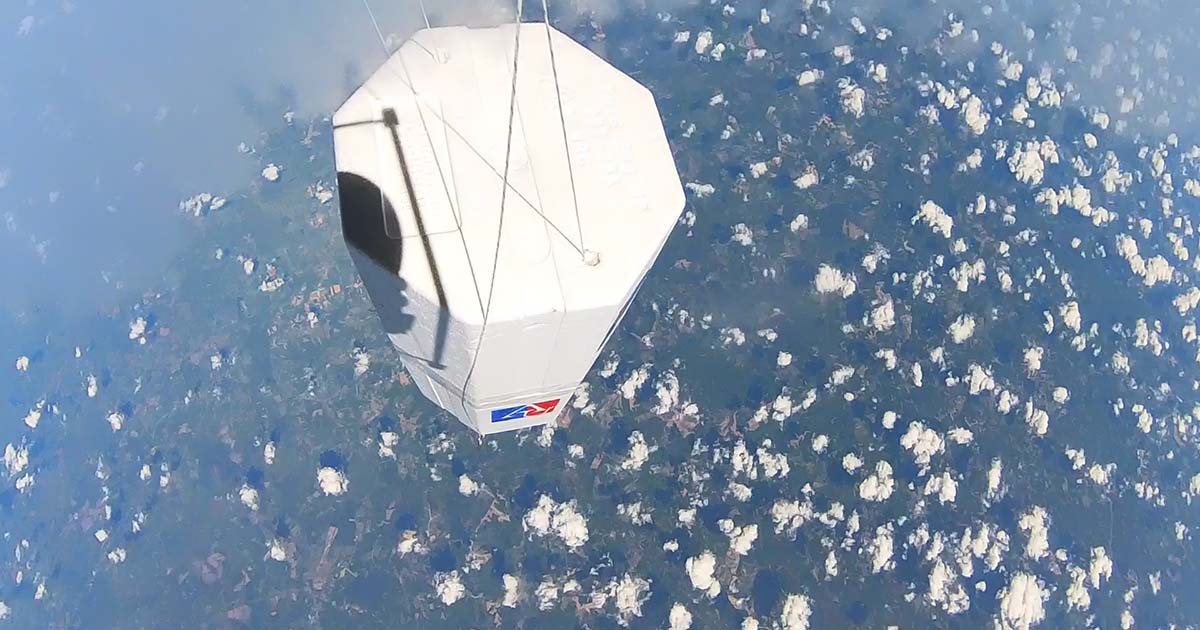High-Flying Physics: Students' Balloon Reaches Stratospheric Heights

On April 28, a group of American University physics students and faculty launched a high-altitude balloon from Virgnia's Brookneal-Campbell County Airport, capturing breathtaking photos and invaluable data from the stratosphere.
The balloon ascended 30 kilometers (approximately 18.64 miles) into the stratosphere and traveled 35 kilometers horizontally before descending. The entire flight lasted about two hours, with the descent occurring rapidly after the balloon burst. The payload was retrieved from a tree in a forested area near Harrisburg, Virginia.
"I am so proud of our physics students and faculty for their initiative and intellectual curiosity in exploring scientific frontiers,” says Linda Aldoory, Dean of the College of Arts and Sciences. “The project truly highlights the spirit of teamwork, hard work, and innovation at the College."
The balloon carried an array of scientific instruments, including GPS devices, cameras, high-energy particle detectors, temperature sensors, a barometric pressure sensor, and an altimeter. Live telemetry and low-resolution imagery were broadcast from the payload using a high-power flight radio to a mobile ground station in a chase vehicle. The instruments collected real-time data on position, air temperature, air pressure, and received signal strength.
Time-lapse panoramic footage recovered from a high-resolution action camera provided breathtaking visuals of the journey. “Despite our efforts to remove humidity from the camera case, frost developed as the temperature plunged below -40°C in the middle of the stratosphere. This sullies the very high-altitude images somewhat, but not our enthusiasm for science!” says Department of Physics faculty member Jonathan Newport. “I want to thank the DC NASA Space Grant Consortium for sponsoring this project and give a special shout out to physics students Eli Rockenbeck and Caleb Dando-Haenisch for being the prime movers of this project.”
See just a few of the photos from the mission!
 Students (left to right) Caleb Dando-Haenisch, Zaki Hawkins, Eli Rockenbeck, and Ihsan Hawkins developing software on the payload.
Students (left to right) Caleb Dando-Haenisch, Zaki Hawkins, Eli Rockenbeck, and Ihsan Hawkins developing software on the payload.
 The balloon payload, prior to final assembly. (Left to right: transmitting antenna, camera for live photos (blue light), flight computer & detector assembly, SPOT GPS for recovery (orange), thermometer (gray cable out front)
The balloon payload, prior to final assembly. (Left to right: transmitting antenna, camera for live photos (blue light), flight computer & detector assembly, SPOT GPS for recovery (orange), thermometer (gray cable out front)
 Caleb Dando-Haenisch (left), Professor Michael Robinson (center), Professor Jonathan Newport (right) prepare balloon for launch
Caleb Dando-Haenisch (left), Professor Michael Robinson (center), Professor Jonathan Newport (right) prepare balloon for launch
 Team prepares balloon for launch.
Team prepares balloon for launch.
 Balloon takes flight!
Balloon takes flight!
 The view from the balloon’s highest point, approximately 30 km above the earth!
The view from the balloon’s highest point, approximately 30 km above the earth!
 Frosty views as the temperature plunged below -40°C in the middle of the stratosphere.
Frosty views as the temperature plunged below -40°C in the middle of the stratosphere.
 Descent. Payload visible as the balloon drops through the clouds.
Descent. Payload visible as the balloon drops through the clouds.
 Just before landing in the trees!
Just before landing in the trees!
 Caleb Dando-Haenisch opening the payload the next morning after its successful recovery.
Caleb Dando-Haenisch opening the payload the next morning after its successful recovery.
